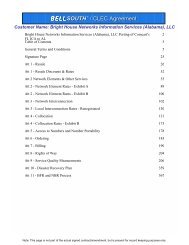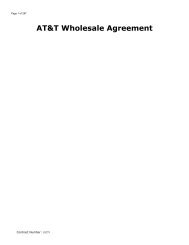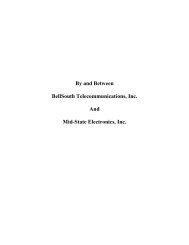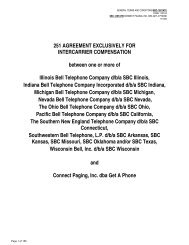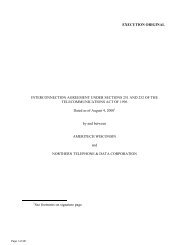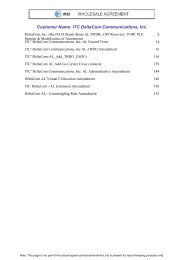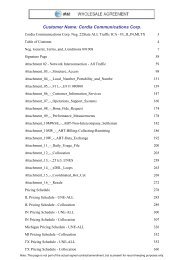Customer Name: Southern Light, LLC - AT&T Clec Online
Customer Name: Southern Light, LLC - AT&T Clec Online
Customer Name: Southern Light, LLC - AT&T Clec Online
Create successful ePaper yourself
Turn your PDF publications into a flip-book with our unique Google optimized e-Paper software.
Page 251 of 374<br />
ATT 4 – COLLOCATION/AT&T-9STATE<br />
PAGE 12 OF 44<br />
<strong>Southern</strong> <strong>Light</strong><br />
1Q08 GENERIC INTERCONNECTION AGREEMENT – 03/10/08<br />
5 Use of Collocation Space<br />
5.1 Equipment Type<br />
5.1.1 AT&T shall permit the collocation and use of any equipment necessary for interconnection to<br />
AT&T’s network and/or access to AT&T’s unbundled network elements in the provision of<br />
Telecommunications Services, as the term “necessary” is defined by FCC 47 C.F.R. § 51.323 (b).<br />
The primary purpose and function of any equipment collocated in an AT&T Premises must be for<br />
interconnection to AT&T’s network or access to AT&T’s unbundled network elements in the<br />
provision of Telecommunications Services. Equipment is necessary for interconnection if an<br />
inability to deploy that equipment would, as a practical, economical, or operational matter, preclude<br />
the requesting carrier from obtaining interconnection with AT&T at a level equal in quality to that<br />
which AT&T obtains within its own network or what AT&T provides to any affiliate, subsidiary, or<br />
other party.<br />
5.1.2 Examples of equipment that would not be considered necessary include, but are not limited to:<br />
traditional circuit switching equipment, equipment used exclusively for call-related databases,<br />
computer servers used exclusively for providing information services, OSS equipment used to<br />
support collocated telecommunications carrier network operations, equipment that generates<br />
customer orders, manages trouble tickets or inventory, or stores customer records in centralized<br />
databases, etc. AT&T will determine upon receipt of an application if the requested equipment is<br />
necessary based on the criteria established by the FCC. Multifunctional equipment placed on an<br />
AT&T Premises must not place any greater relative burden on AT&T’s property than comparable<br />
single-function equipment. AT&T reserves the right to allow the collocation of any equipment on a<br />
nondiscriminatory basis.<br />
5.1.3 Such equipment must, at a minimum, meet the following Telcordia Network Equipment Building<br />
Systems (NEBS) General Equipment Requirements: for Central Offices Criteria Level 1<br />
requirements as outlined in Telcordia Special Report SR-3580, Issue 1 and for Remote Sites<br />
Criteria Level 3 requirements as outlined in the Telcordia Special report SR-3580, Issue 1. Except<br />
where otherwise required by a Commission, AT&T shall comply with the applicable FCC rules<br />
relating to denial of collocation equipment based on <strong>Southern</strong> <strong>Light</strong>’s failure to comply with this<br />
Section.<br />
5.1.3.1 To the extent <strong>Southern</strong> <strong>Light</strong> wishes to place equipment in its collocation that does not meet the<br />
standards set forth in 5.1.3, <strong>Southern</strong> <strong>Light</strong> may request in writing, pursuant to the Notices section<br />
of the General Terms & Conditions, a waiver to such standards. AT&T may provide a waiver in its<br />
sole discretion.<br />
5.1.4 At a Remote Site, all <strong>Southern</strong> <strong>Light</strong> equipment installation shall comply with AT&T TR 73503-11h,<br />
“Grounding - Engineering Procedures”. Metallic cable sheaths and metallic strength members of<br />
optical fiber cables as well as the metallic cable sheaths of all copper conductor cables shall be<br />
bonded to the designated grounding bus for the Remote Site Location. All copper conductor pairs,<br />
working and non-working, shall be equipped with a solid-state protector unit (over-voltage<br />
protection only), which has been listed by a nationally recognized testing laboratory.<br />
5.2 Terminations. <strong>Southern</strong> <strong>Light</strong> shall not request more DS0, DS1, DS3 and/or optical terminations<br />
for a collocation arrangement than the total port or termination capacity of the equipment physically<br />
installed in the Collocation Space. The total capacity of the equipment collocated in the Collocation<br />
Space will include equipment contained in an application, as well as any equipment already placed<br />
in the Collocation Space. If full network termination capacity of the equipment being installed is not<br />
requested in the application submitted by <strong>Southern</strong> <strong>Light</strong>, additional network terminations for the<br />
installed equipment will require the submission of a Subsequent Application. In the event <strong>Southern</strong><br />
CCCS 251 of 370



